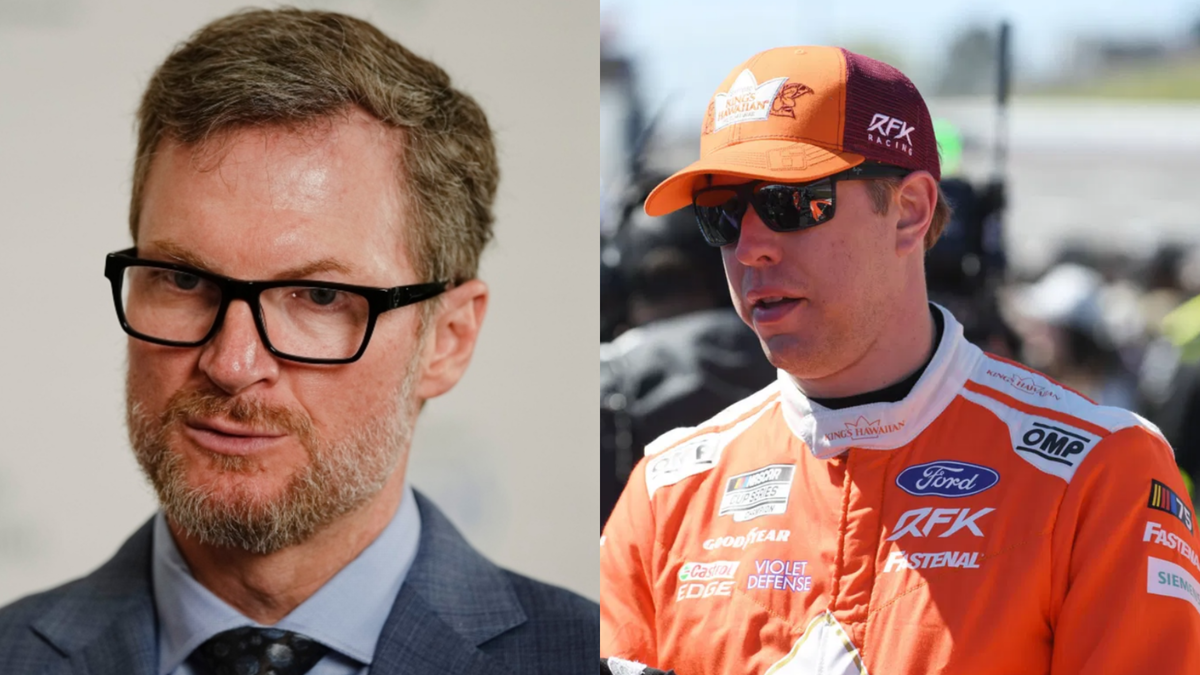

Brad Keselowski is far from alone in his rant about road courses. Three-time Daytona 500 winner Denny Hamlin took his shot, too, declaring that “Six is a lot considering that we are NASCAR.” Richard Petty also echoed this stance after Shane van Gisbergen’s Mexico City win locked him into the playoffs, saying, “You’re making a championship situation by winning a road course, which is not really NASCAR to begin with.” Now Dale Earnhardt Jr. has joined their side.
Watch What’s Trending Now!
Brad Keselowski’s discomfort with NASCAR’s growing road course presence came to a head after a chaotic crash at the Chicago Street Course reignited the debate over the sport’s changing identity. A 36-time Cup Series winner and co-owner at RFK Racing, Keselowski has been vocal about his belief that NASCAR was built on ovals and that the shift toward twisty layouts is pulling the sport away from what made it special. That frustration only grew when, on lap four in Chicago, Carson Hocevar clipped the wall exiting Turn 10 and triggered a chain-reaction crash that caught Keselowski and several others. His No. 6 Ford suffered a broken front suspension, ending his race early, knocking him out of the In-Season challenge, and handing a million-dollar prize to Ty Dillon, who trolled the veteran driver, too. It was his sixth DNF of the year, and for Keselowski, the kind of wreck just proved how little room for error street circuits leave.
The discussion intensified after motorsport journalist Pete Pipstone posted on X, crediting fans for pushing NASCAR towards more road course events. Brad Keselowski responded with a direct post, doubling down on his belief that the change risks diluting NASCAR’s identity. Taking to X, the veteran driver didn’t mince words. He said, “We went from 2 to 6 Road course races, possibly 7 next year. NASCAR was successfully built as a primarily oval racing series. IMSA was built as the primary road course series in North America. IMSA will always do road racing better than NASCAR, and that’s ok. Yes, TOO Many Road courses in NASCAR.”
ADVERTISEMENT
And Dale Earnhardt Jr. wasn’t one to shy away from supporting Brad. Dale Jr. has been very vocal about his stand on road courses. On an episode the of Dale Jr. Download, the Hall of Famer said, “I don’t like the road courses right now. I would say my favorite thing about our sport is probably the Charlotte’s and the Kansas’s… I used to not want them added, but I am sort of understanding…they’re going to do what they’re going to do.” And in reply to Brad’s post on X, Dale Earnhardt Jr. summed up his emotions with a GIF that said, “You are absolutely correct.“
— Dale Earnhardt Jr. (@DaleJr) July 10, 2025
Brad’s comments stirred wider conversation in the paddock and online, raising questions about how NASCAR balances its tradition with innovation. While acknowledging the skill it takes to compete on road courses, Keselowski pointed to IMSA as the rightful home of road racing in North America and emphasized that NASCAR should stay true to its roots.
ADVERTISEMENT
Historically, NASCAR ran only two dedicated road-course events—Sonoma Raceway and Watkins Glen International, for nearly three decades. But since 2021, that number has ballooned to six, with races at Watkins Glen, Sonoma, COTA, Charlotte Roval, Chicago, and Mexico City; some reports suggest seven could be on the horizon. While six of 36 races, about 17%, might seem modest, legacies like Keselowski and Earnhardt Jr. argue that replacing traditional ovals with these technical circuits matters more than the raw percentage. His rant and Dale Junior’s support have left fans divided into team road courses versus team oval tracks.
ADVERTISEMENT
Fans are split on the verdict of road courses in NASCAR
While Brad Keselowski’s passionate stance on the increasing number of road courses has drawn plenty of support, it has also sparked some spirited pushback from NASCAR fans who see things a little differently. After all, there are 30 oval races still locked into the current schedule; many argued that the sport’s core identity hasn’t strayed as far as Keselowski fears.
One fan bluntly put it, saying, “I would argue that 30 oval races on the schedule means we are still, in fact, a primarily oval racing series.” Another chimed in, questioning the fuss altogether, “31 ovals isn’t enough for Brad?” It’s a fair question for those who see the current road course expansion not as a hostile takeover, but as a refreshing sprinkle of variety.
However, there is nostalgia too. For the days when only two road courses, Watkins Glen and Sonoma, punctuated the season. One longtime fan admitted, before adding a more measured view, said, “I preferred it when there were two. I much prefer ovals and drafting, but that’s just me. In the end, I’m happy to do whatever possible to get more eyes on the sport.”
ADVERTISEMENT
That willingness to evolve has become part of NASCAR’s survival strategy, with the road courses offering new markets like Chicago, unpredictable racing, and unique challenges. But not everyone is sold on their entertainment value. One user very colorfully put it, saying, “NASCAR road races play out like taxi-cab racing most of the time.” Suggesting that finesse and racecraft sometimes get lost in the stop-start nature of these layouts, still, the overarching tone of the backlash wasn’t exactly panic. For many, the numbers speak for themselves, and the shift doesn’t feel as seismic as Keselowski suggests. As one fan summed it up with a shrug, saying, “Less than 20%…it’ll be ok, Brad.”
In the end, the debate reflects a large amount of attention in NASCAR. The balance between preserving tradition and embracing innovation, and for now, that conversation is still very much racing down both sides of the track.
ADVERTISEMENT
ADVERTISEMENT
ADVERTISEMENT
ADVERTISEMENT

